We’re all familiar with the phrase “knowledge is power”. When it comes to leveraging your supporters to spread the word about your crowdfunding campaign and fundraise on your behalf (i.e. peer-to-peer fundraising), that sentiment is not just true, it’s essential. In order for them to effectively promote your campaign and garner donations, you need them to be armed and ready with all of the nitty-gritty, need-to-know information.
Peer-to-peer fundraising is a great way to attract new donors, reach a wider audience, and engage your current supporters. But, what exactly is it? Put simply, it’s a fundraising method that leverages your existing audience to raise money on your behalf. Think about a fundraising walk or run where supporters can pledge a specific amount of money for every mile that a personal fundraiser completes. That’s a great example of peer-to-peer fundraising.
This method can be an incredibly powerful way to expand your reach.
Need inspiration for your toolkit? Download 10 Peer-to-Peer Fundraising Toolkit Examples:
But, not everyone that is inspired to fundraise for you has the skills and know-how to reach their fundraising goals.
That’s where you step in.
You’ll want to equip and educate your fundraisers in order for them to reach their full potential. However, that can definitely be a challenge—especially if you’re lucky enough to have an extremely large network of supporters and fundraisers. You don’t have time for a one-on-one phone call with everyone, emails tend to get lost in the shuffle, and carrier pigeons have become a little obsolete.
So, what can you do in order to make sure you get your campaign’s important information into the eager hands of your personal fundraisers? Create a campaign toolkit, of course!
We’ve seen thousands of peer-to-peer fundraising campaigns succeed on CauseVox, and one of the key strategies that ultimately best leverages their fundraisers and raises the most are those that put time and effort into crafting a toolkit for their fundraisers.
Floyd Jones, who has ran over 11 wildly successful peer-to-peer fundraising campaigns on CauseVox, knows that empowering your peer-to-peer fundraisers and equipping them to succeed is crucial to fundraising success.”When you’re in a position of leadership, your job becomes creating a space for others to thrive and do what they can do best.”
Creating a toolkit for your peer-to-peer fundraising campaign isn’t just a nice-to-have. It’s an essential part of preparing your fundraisers to meet their goals, so they in-turn can help you meet yours. A peer-to-peer fundraising toolkit is not only useful for giving fundraisers the resources they need to promote your cause and successfully participate but also to ensure that you maintain your cohesive brand identity while they do so.
It might seem overwhelming to decide how to organize all of the information about your organization and campaign, but don’t worry: we heard you like toolkits, so we made a toolkit for your toolkit. We’ll walk you through all the steps so you can build your own highly effective peer-to-peer fundraising toolkit
Toolkit Basics
You’re probably raring and eager to whip together the best collection of resources your supporters have ever seen. But before you can dive headfirst into creating a toolkit for your campaign, it’s important to first have a solid understanding of what exactly it is. The name is a good clue: you’re providing all the tools your fundraisers need in one clear, easy to access location.
Essentially, it’s a set of different resources, graphics, tips, and templates that your supporters can use to effectively promote your mission in a way that fits with your current brand and voice.
Including everything from your logo and campaign hashtag to your brand guidelines and printable materials, your toolkit acts as a one-stop-shop for your supporters to get everything they need to spread the word about your great work and their personal fundraising efforts.
OK, so all of that sounds handy. But, why on earth do you actually need a toolkit? Well, putting together one of these helpful kits offers numerous benefits for your campaign.
- It expands your reach. You’re fortunate to have a large network that’s willing to help you spread the word. But that benefit quickly falls apart if your supporters are blanketing the world with incorrect information. Arming them with a toolkit will ensure that they’re able to share accurate and updated facts about your campaign. Plus, being well equipped will likely give your supporters the extra boost of confidence they need in order to continue garnering support and donations.
- It maintains your brand integrity. You’ve worked hard to develop and hone your brand voice and guidelines. So, you don’t want them all to be thrown out the window when you start having supporters speak on your behalf. Including important notes and rules regarding your brand will ensure that your integrity and reputation is never tarnished or compromised, and that you always maintain a cohesive brand identity!
- It engages your supporters. You’re always looking for ways to further engage your supporters (at least, you should be!). Giving them the tools they need in order to feel like a part of your campaign’s promotion and success is a great way to do so.
- It helps your supporters to be successful in fundraising. Not only does this make them feel good about helping you, it also means that your fundraising campaigns raise more.
Here’s what Floyd Jones from Volo City Kids Foundation had to say about how toolkits fit into their peer-to-peer fundraising success, “We started our first ever campaign for #GivingTuesday (this is years ago now), and we ended up doing really well. And the reason why is that we made it easy and we empowered people. People generally want to do good, and fundraising gives them the opportunity to do that. And so now you have all the resources through CauseVox, through a toolkit, and through social media to help them do good.”
Since then Floyd has incorporated toolkits into his 11 fundraising campaigns, making it a central way he empower fundraisers to reach success. These toolkits are the foundation of his peer-to-peer campaigns, allowing him to empower his fundraisers while trusting that they’ll represent his brand well.
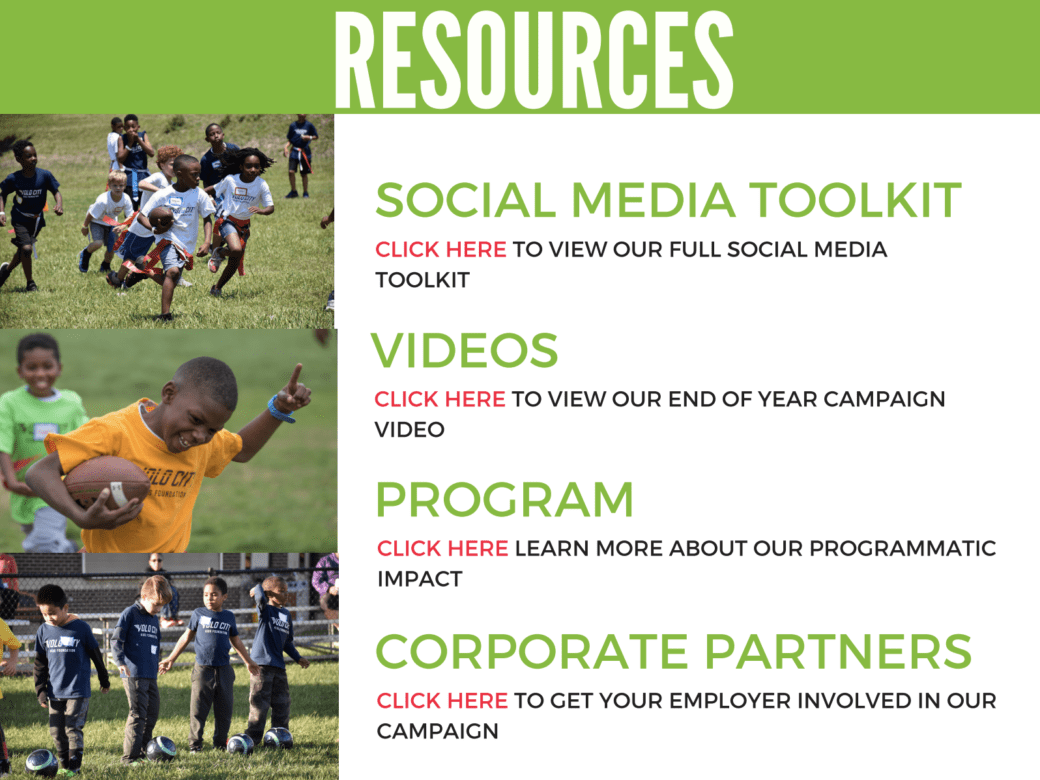
Now that you know the basic gist and benefits of a campaign toolkit, you might be wondering about the best methods for distributing this to your audience.
There are numerous options you can choose from, including a download on your website, sending it out via email, offering all of your supporters a thumb drive, or even setting up a shared Google Drive folder. Take some time to identify the option that works best for you, and then run with it!
Of course, all of that is logistics. The most difficult part of piecing together your toolkit(s) for your crowdfunding campaign is determining what resources should be included. But, you’re in luck! The rest of this online guide provides plenty of inspiration and ideas for the different types of tools you can offer your supporters.
Keep it Simple
Before you start thinking about what kind of content you want to include in the guide, it’s a good idea to think about the tone, layout, and approach you’ll take. This guide should be as accessible as possible so that your supporters actually use it (we all know the pain of creating a beautiful piece and having exactly 1 person read it).
A giant wall of text can be overwhelming to the layperson. Think about creating content that is visually appealing and fairly simple. You don’t have to include every detail about your organization: just enough that your fundraisers can give an elevator pitch. You can use design and formatting to keep the content clear, and to highlight important information. Check out this example from Fiver, which uses a clear numbering hierarchy to break up the text abd make the page easy to approach.

Another element that can make your fundraising guide significantly easier to use is to provide your supporters with a clear person they can reach out to for help. Having a specific name can feel more approachable than a generic email address.
Before you share your toolkit with the world, try running it past a few of your colleagues who know nothing about the campaign you’re running. Do they get overwhelmed or confused? Can they help you find places to simplify or clarify? Especially if you’re using an online peer-to-peer platform, try running the toolkit past people with different levels of technological comfort to make sure you’ve clearly explained the processes.
Now that you have your approach in mind, let’s get into the specifics of what to include.
Brand Guidelines
First things first, you should detail some brand guidelines within your toolkit. These should appear early on, so that personal fundraisers can review them before making use of any other items and ensure that all of their promotional efforts are maintaining the integrity and identity of your entire brand.
Here are the core elements to include in your brand guidelines:
- Mission and Values: Clearly outline your campaign’s specific mission and values for your supporters to easily reference. This overview reinforces your goals, and also offers supporters a general idea of the ideals they should keep in mind when representing your brand.
- Brand Voice: If your supporters will be posting to their social media accounts or blogs, offer some advice about the overall personality of your brand. Are you fun and conversational? Or, are you more formal and dry? Are you humorous, and maybe even a little snarky? Or, are you strictly professional and educational? Providing these details ensures messages from your supporters are cohesive with your entire brand identity.
- Requirements: Does your logo need to be used in a specific placement or manner? Do you always link to a specific spot on your fundraising page? This is your place to list any need-to-know details your supporters and participants should be aware of.
- Restrictions: If there are any words, websites, or other related things that are off limits for fundraisers, make sure you explicitly mention them so that they’re in the loop about resources and phrasing they should avoid in their promotions.
You can see a great example of this here from the One Step Forward Bikeathon, who gave their fundraisers specific language and ideas to approach businesses.
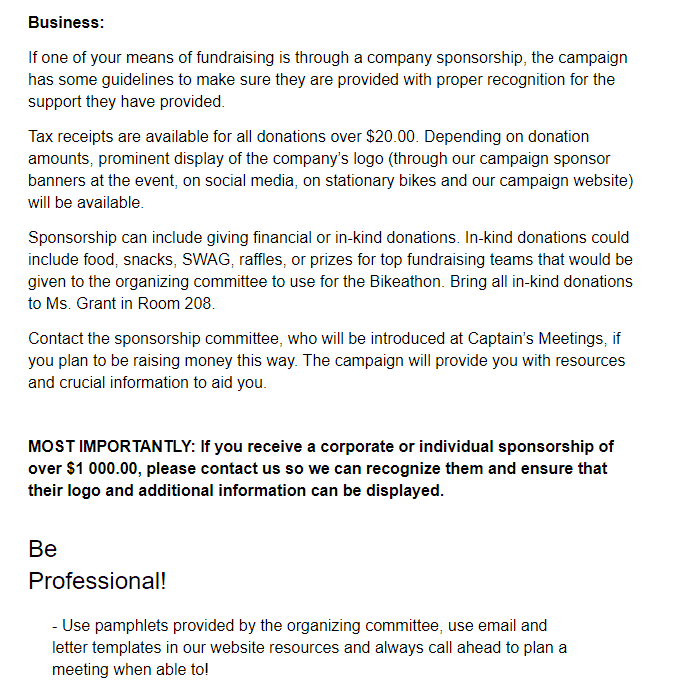
Overview of Campaign
Next, you want to equip participants with the quick hits of your campaign. This explains the who, what, where, when, and why, so that your fundraisers can efficiently and thoroughly explain the mission of your campaign when they’re prompted by potential donors.
Not only does this overview detail all of the nuts and bolts of your campaign, it also acts as a great handout for supporters to distribute when asking for donations. They can use it at presentations, networking events, meetings, and other functions where they’re chatting about your mission and their participation.
Faith in Action did a great job of this in their toolkit for the Together We Give campaign. They split their overview into two main sections: one details the who and the why, while the rest gives info about what and where.
This first section gives supporters a direct quote to use while also providing context about why the campaign needs fundraisers.
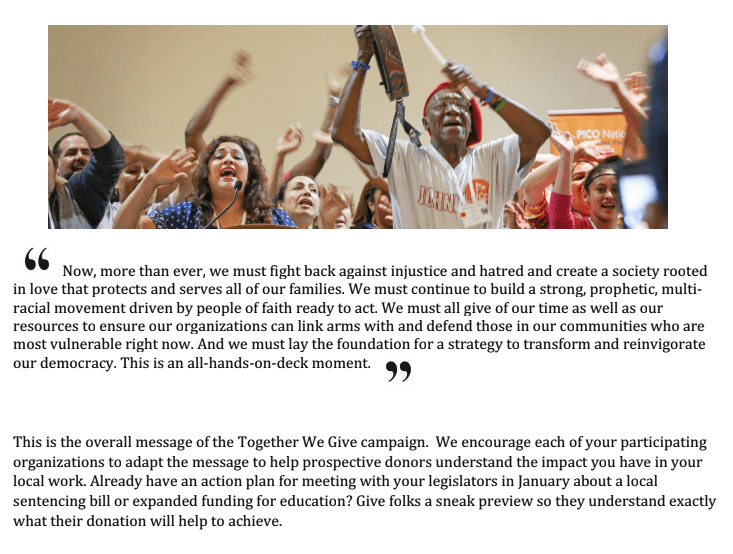

After showing supporters why the cause is important, Faith in Action lays out in chronological order the steps of running the campaign so that the fundraisers know exactly what they should do at each step in the process.


One of the best parts of this list is that it’s clearly formatted and easy to read, plus it includes information about specific dates and times so that fundraisers can put it on their calendars. This information is all within the first three pages of the toolkit as well, which means fundraisers get the crucial details quickly.
Communication Calendar
Now that your fundraisers can visualize what’s going to happen you can zoom in a little bit further and give them some specifics. A great resource to include early on is a sample calendar of how often to send communications. Lay out a sample week with e-mails, social media, or face-to-face interactions. You can also give guidelines about how often to use a specific kind of ask, for example one email every two weeks or one Facebook post each week.
The Autism Society of Minnesota used this concept to create a “$500 in one week” guide. Each day of the week they shared one action and the amount that a fundraiser can ask for to reach $500 by the end of the week. You can customize this to your campaign and give examples that make sense for your organization.
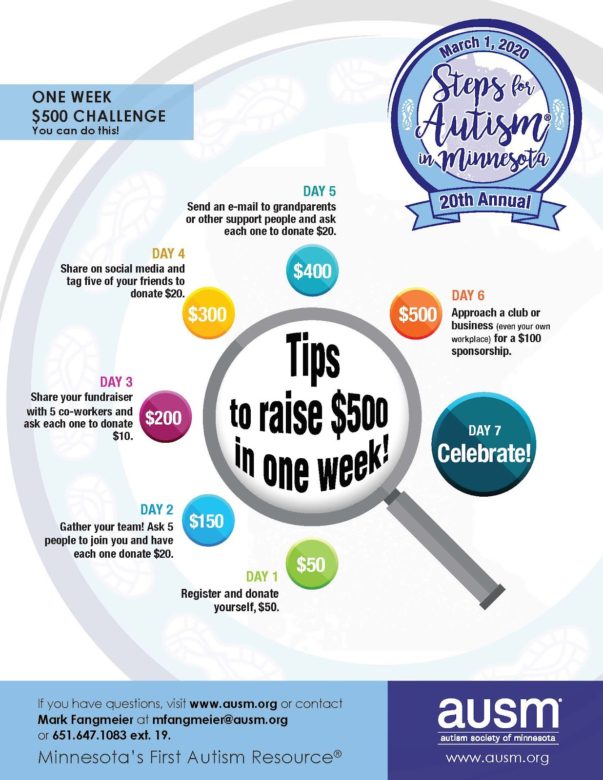
Images and Logos
We live in a visual world, and powerful and impactful imagery can go a long way in promoting your cause. After all, there’s a big difference between telling someone about your mission and showing them. So, arm your supporters with plenty of image files that they can make use of.
What sorts of images should you include? Well, quite simply, the more the better! Here are a few ideas:
- Social Media Graphics: Research shows that photos are the most engaging type of content on Facebook (with a mind-blowing 87% interaction rate!). So, make sure you’re offering participants and supporters some impactful photos they can include with their social media posts or set as their cover photo. Pull options that are clear, attention grabbing, and accurately illustrate the need for your campaign. The Faith in Action campaign has some great examples in their “Sample Tweets” section.

- Logos: Give supporters a few different versions of your campaign logo so that they can use it on promotional materials, correspondence, and other campaign-related pieces they need to send out. It keeps all of your campaign marketing branded!
- Visual Stories: Graphics that contain both a moving image and a powerful description are incredibly effective tools for your supporters to use on social media and other promotional handouts. Fiver Children’s Foundation built a series of Instagram graphics that shared the impact of their work so that fundraisers just have to share.
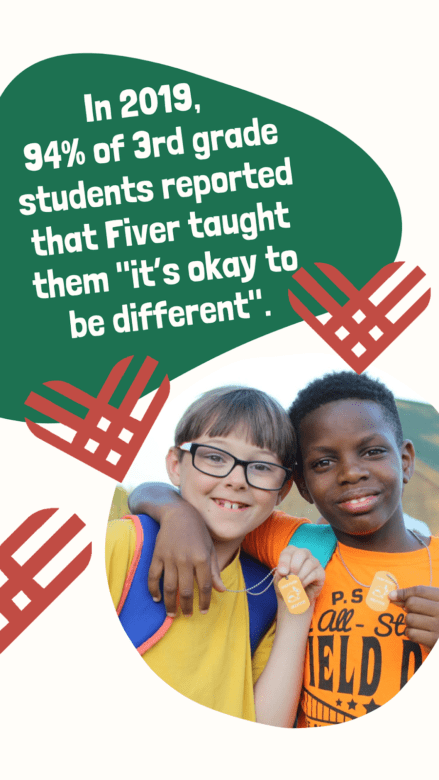
- Promotional Graphics: You can also include some different sized graphics for use in emails, newsletters, printed flyers, and other pieces that your supporters and participants might pull together. After all, you’d rather have fundraisers armed with too many tools to make use of — rather than not enough! Fiver Children’s Foundation created a beautiful graphic that fundraisers can share on social about Giving Tuesday and shared it in their toolkit.
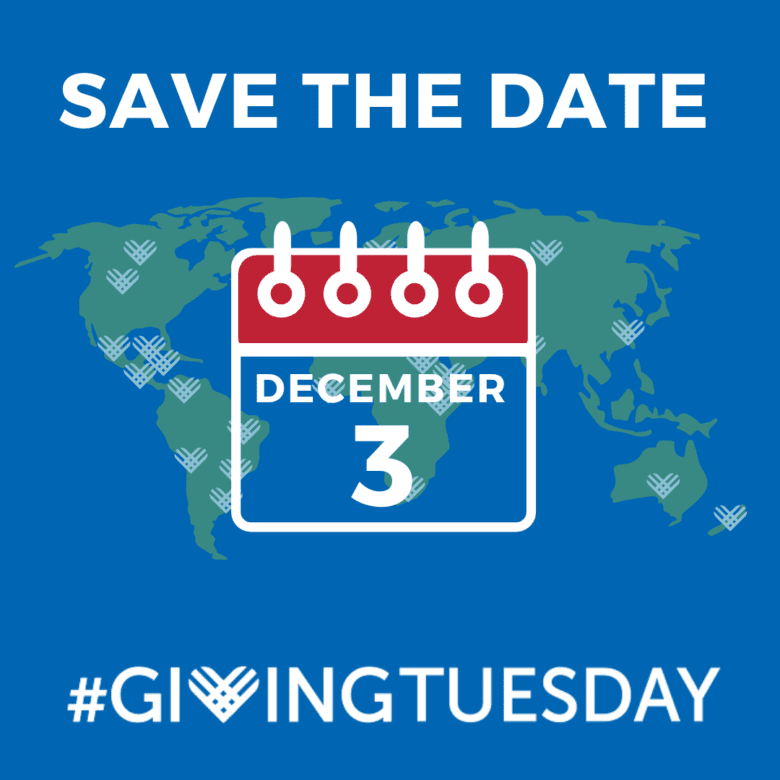
Social Media Tips
We all know that social media has an undeniably large influence, and it’s a great place to promote your campaign. But, keep in mind that even though your supporters likely use social media for personal updates, they might not be as confident when it comes to promoting their fundraising efforts.
Including various social media tips and suggestions in your toolkit is a surefire way to help your fundraisers craft social posts that are compelling and engaging. Here are a few different tidbits to include in the social media section:
- Hashtags: Detail the specific hashtags participants should use with their social posts so that you can successfully group these posts and monitor their impact and engagement.
- Links: If you’ve enabled tracking on any specific links, make sure to encourage your supporters to use those specific ones so that you’re getting accurate analytics.
- Canned Posts: Create a few prepared tweets and posts that your fundraisers can directly copy and paste into their own accounts. This makes it incredibly easy for them to use their social platforms, and also gives you complete control of the message!
- Your Social Accounts: If your supporters aren’t already following you on social, they should be! So, list your different social media handles and encourage them to follow you and tag you in campaign-related posts.
- Tips and Tricks: Don’t hesitate to offer any other guidance or advice on creating engaging posts. Is there a certain time of day that you’ve found to be a particularly effective time to post? Have you noticed that your photos tend to get more engagement than a standard text post? Let your supporters know!
Correspondence Templates
Having your personal fundraisers send out emails, letters, or press releases in order to fundraise on your behalf is incredibly effective. But, it can also be somewhat nerve-wracking for them!
Ease their anxiety by including some simple-to-use correspondence templates for them to edit and make use of. Volo City Kids Foundation provided an email template to all their fundraisers, who simply had to fill in their own name and send the email. This makes it incredibly easy for your fundraisers to make an ask.
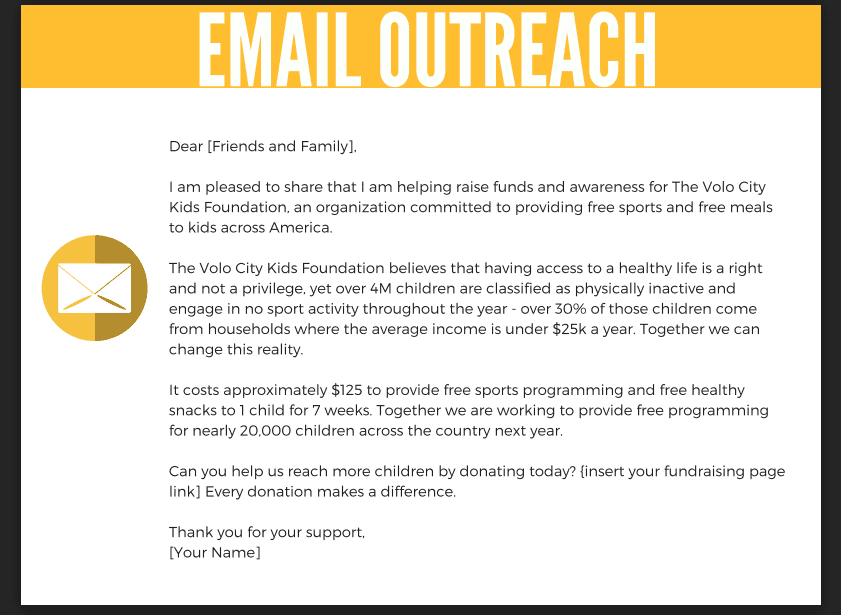
Think of any other potential correspondence your network of supporters might need to distribute, such as a traditional letter or even a script for a phone call, and provide a simple template for them to edit. It takes the guesswork out of it for them — making them more likely to hit the ground running with their personal fundraising efforts!
Printable Promotional Materials
Sure, much of our promotions today involve digital efforts. But, there are still plenty of people who like to actually have something to take home with them. So, ensure that your toolkit includes PDF downloads of printable promotional materials that your fundraisers can distribute at their places of employment, community organizations, churches, and other locales that they frequent.
Whether you want to create a poster, a simple one-sheet flyer, or a complex brochure, equipping your supporters with tangible pieces that they can dole out is an effective strategy to spread your message.
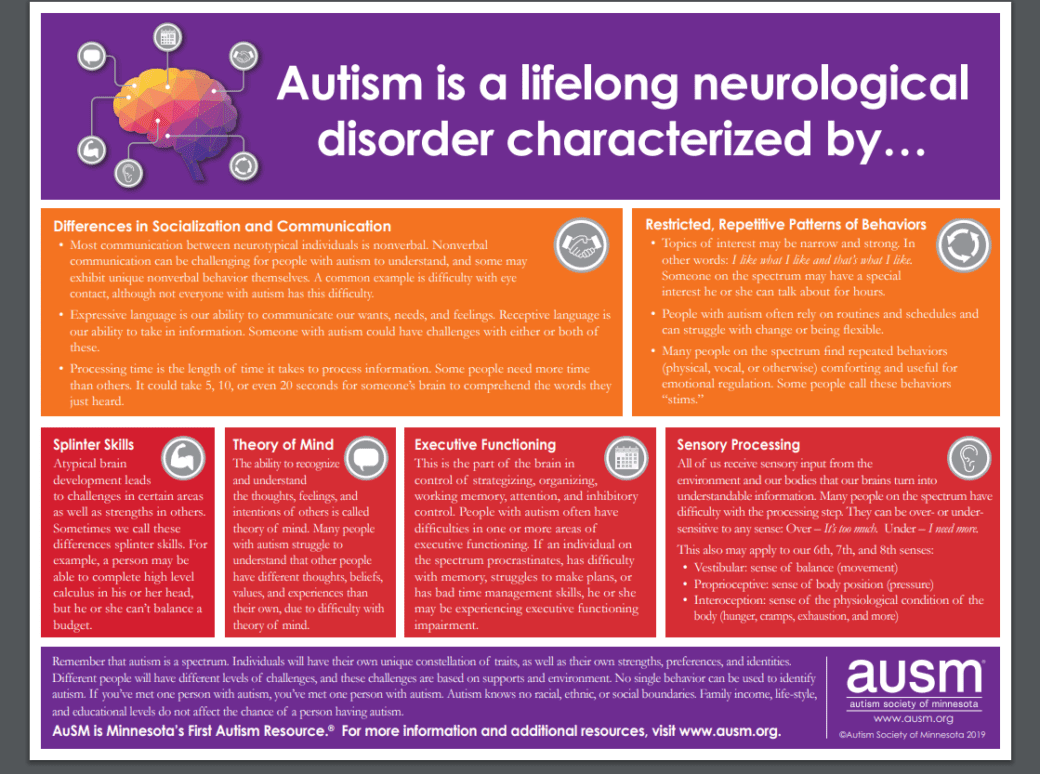
The Autism Society of Minnesota created this one-pager that supporters can use to explain the disorder and share information with potential donors. This allowed fundraisers to educate their networks on the importance of the cause, while also increasing awareness.
Take some time to think of any pieces of information that your participants might want to leave with people, and then create simple documents around those concepts. They don’t need to be complicated. But, your supporters will appreciate having something that they can physically distribute to potential donors.
Some of your physical materials may not be for donors, but instead can contain important information for the events tied to your fundraiser. Check out this great ride schedule from One Step Forward’s Bikeathon.
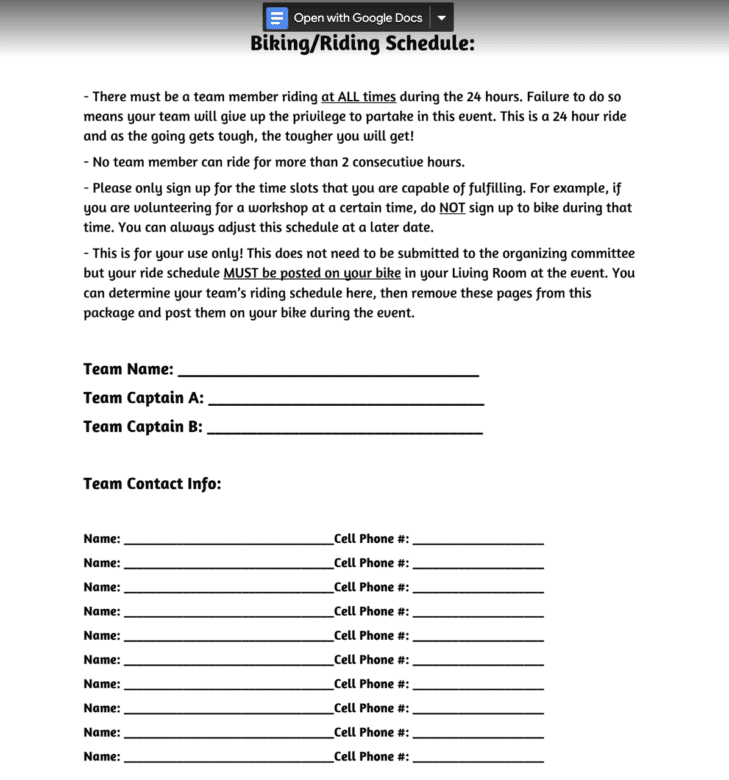
Thank You And Recognition Tools
You already know that recognizing those who donate to your cause is incredibly important for fostering and maintaining loyalty to your campaign. So, be sure to provide different tools that your participants can utilize to thank and recognize their supporters and donors.
Not sure what methods you can implement in order to give a hearty “thanks”? Here are a few ideas!
Graphics: A fun graphic that can be posted on social media or sent out via email is another great way for your fundraisers to show gratitude to their donors.
Social Media Announcements: Here’s another opportunity for you to craft some canned social media posts for your participants. Be sure to include one specifically geared towards thanking donors that your fundraisers can post after they receive a new donation! For example Faith in Action created a beautiful
Faith in Action created this thank you template for their Together We Give campaign so that fundraisers know how to keep their donors in the loop.
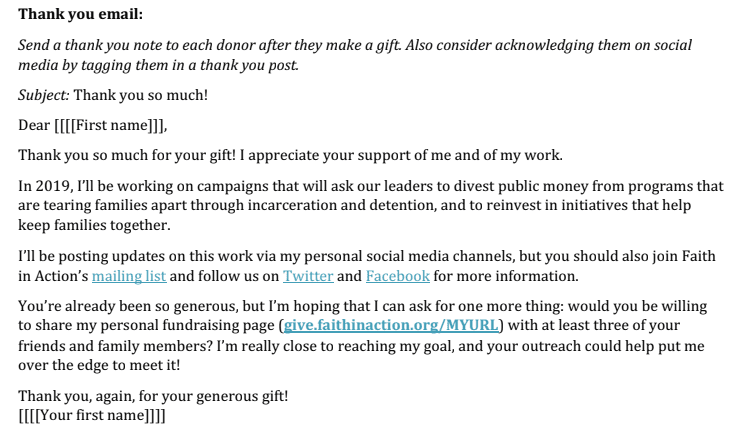
Frequently Asked Questions
When you’re coordinating a campaign — particularly when it involves an element of peer-to-peer fundraising — there will undoubtedly be tons of questions cropping up. Including an FAQ sheet detailing answers to many common inquiries will help your participants be more informed, as well as save you from an overflowing inbox of repetitive questions.
When it comes to your FAQ document, there are two different ways you can approach it:
- Answering your fundraisers’ questions about their efforts: If you’ve organized a peer-to-peer fundraising campaign where participants are personally raising money on your behalf, they’ll likely run into many questions about all of the logistics of the campaign. When does it end? How do they set up a personal fundraising page? This document answers common questions that your fundraisers might have about how the entire fundraiser actually works.
- Answering donors’ questions about the campaign as a whole: When you have participants raising money for your campaign, they’ll likely get questions from potential donors about your cause. Obviously, you want them to be prepared to answer these questions efficiently and eloquently. How much of my money is actually donated to the cause? Is this donation tax deductible? So, this document details the questions that your fundraisers will likely be asked by potential donors, as well as suggested answers.
If you’d like to cover all of your bases, go ahead and put together both documents. That way, your participants have all of their own questions answered — and are also prepared to answer any questions from donors!
Results and Outcomes
As you already know, people aren’t typically inclined to throw their money at something without knowing where exactly it’s going. So, if you have the information and statistics available, create a report or fact sheet that clearly outlines the difference that your campaign makes and the value it provides.
So Every Child Can Play did a great job of this by showing very directly how much impact each dollar has. They outlined how much it costs to fund a single child in sports programming so that fundraisers can see how many kids they’re helping.
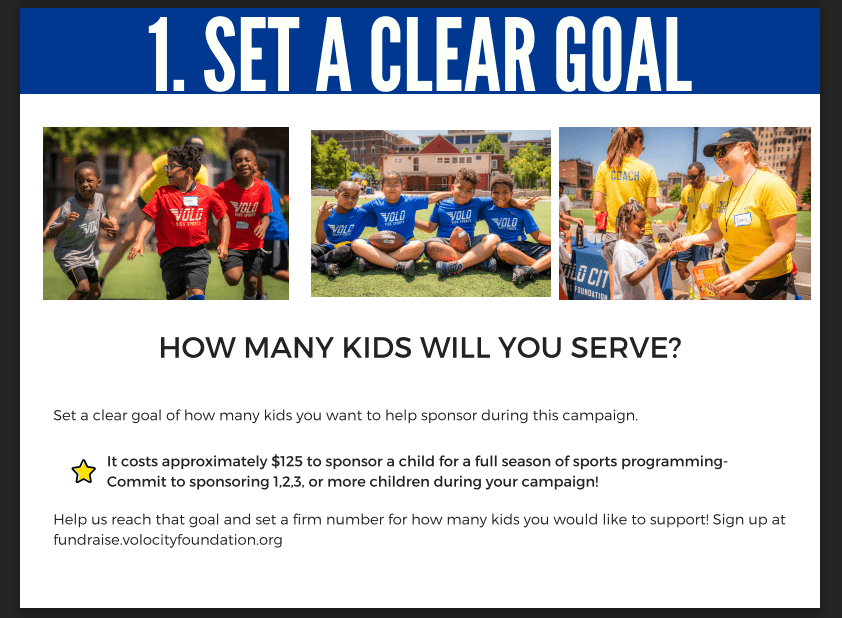
But, don’t be overwhelmed in thinking that your report absolutely needs to be this meticulous. This much information is great! But, any information that you can offer your audience is better than nothing. A simple one sheet explaining the impact your campaign has had so far will definitely fit the bill.
So, pull together any impressive facts and figures that can be used to convince your audience of the value of your campaign. It will help them to feel more confident about the value and impact of their donation.
Fundraising Tips
So, you have active participants that want to fundraise on your behalf. That’s great! But, keep in mind that not everyone is completely comfortable acting as a salesperson. So, your fundraisers might run into issues when it comes to approaching people for donations and effectively “selling” your campaign.
What can you do to help them along? Include a document with some fundraising tips in your toolkit! This document can function as a step-by-step guide for how to fundraise for your campaign.
Stupid Cancer created an entire fundraising 101 section of their toolkit, with information about how to talk about Stupid Cancer, suggestions for making asks, how to use social media, and where you can find potential donors.
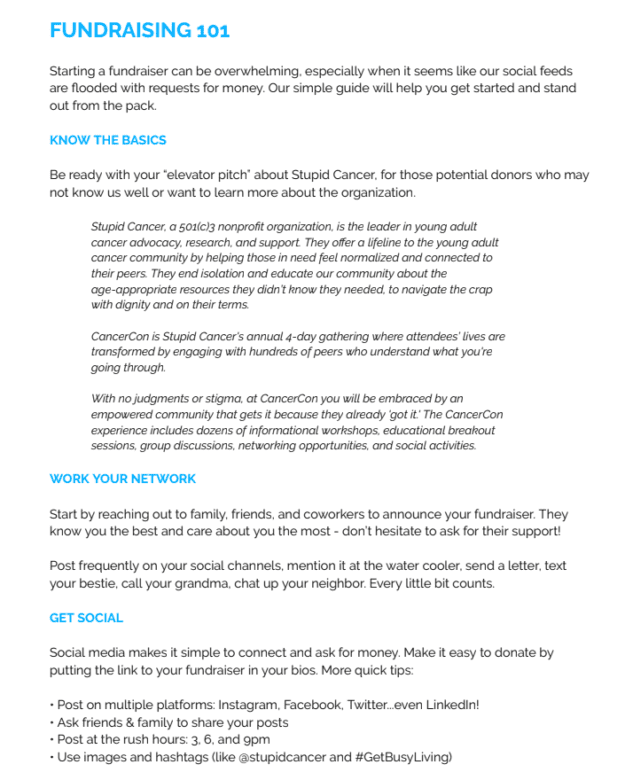
Compiling a fundraising guide for your participants will not only reinforce how you envision the entire process working, but also give your fundraisers the confidence they need to get out there and collect more donations!
Setting Up A Personal Fundraising Page
Now that you’ve pulled together all of these amazing tools and resources, you’re ready to send your fundraisers out into the world. But, wait! You likely don’t want them just accepting fistfuls of cash from donors, right? So, where should they send those that are interested in offering monetary support?
Want the short answer? You should set up a campaign site that allows for personal or team fundraising pages. Sounds convenient, doesn’t it? But, what exactly does this mean?
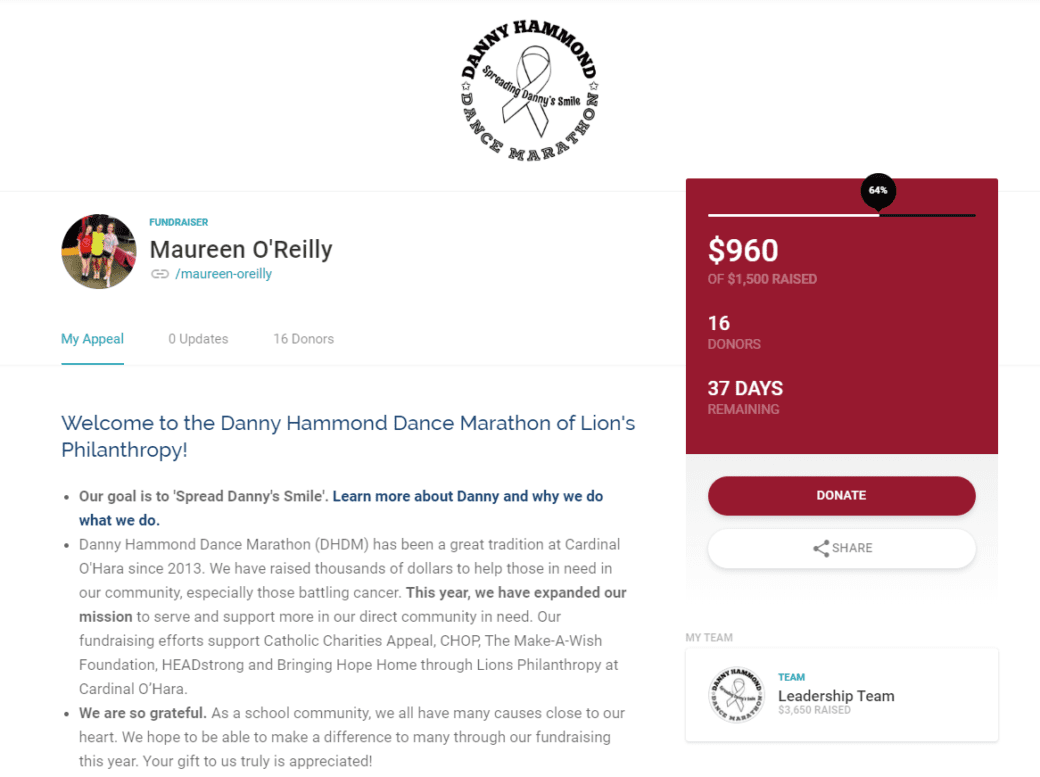
Personal fundraising pages are sub-pages under your main campaign site that allow other individuals to help you raise funds for your campaign. Participants will have their own fundraising page where they can direct their supporters. But, all donations made on those pages will be collected and contributed to your main campaign goal.
Team fundraising pages are pretty similar. However, they’re essentially groups of personal fundraising pages under your main campaign page. By using team pages, fundraisers can form groups and monitor their progress together. Teamwork for the win!
Curious as to how you can go about getting these handy pages up and running? Have no fear — CauseVox makes setting up these pages a breeze!
Learn more about<a href="https://www.causevox.com/peer-to-peer-fundraising-software/" target="_blank" rel="noopener" aria-label=" how CauseVox gives your fundraiser's a great experience with how CauseVox gives your fundraiser’s a great experience with <60 peer-to-peer page setup.
Prepping Fundraisers Outside Of Your Toolkit
Toolkits can do a lot of the heavy lifting to make sure your fundraisers are on the same page as your organization, but no one can do everything: sometimes your toolkit needs a few backup players to bring everything together. There are some other strategies you can use to make sure your fundraisers are successful.
A great option that Faith in Action highlighted in their toolkit is the webinar.
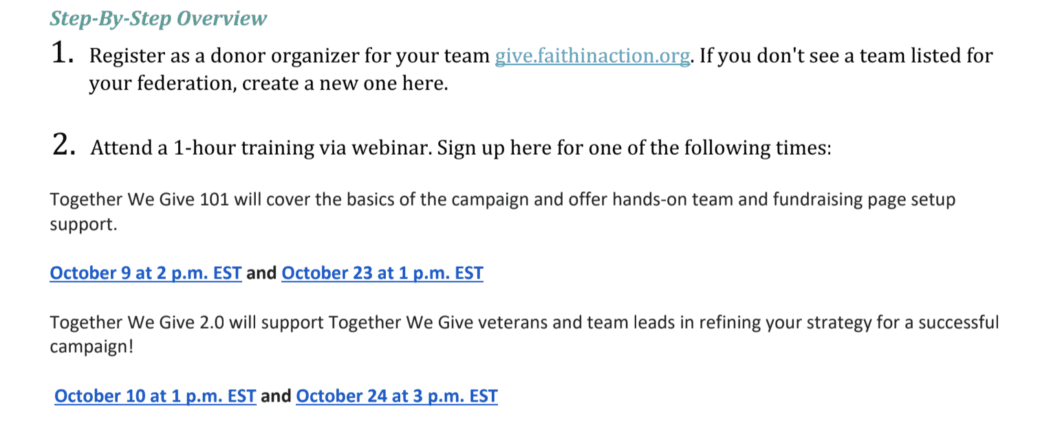
Put together a one hour presentation giving an overview of your event and the best tips and tricks you know and invite your fundraisers to view it online. You could even provide a training in person if you want to go analog. These trainings provide an incredibly important feature that the toolkit doesn’t: interaction. If fundraisers have questions or need specific help, you’ll be there to guide them.
Kelly Boehms of Faith in Action has found that trainings don’t just give information, they can create emotions: “I’m doing weekly trainings for folks on how to use the CauseVox program, and how to make the ask, and how to actually plan. I’m doing a series of hour long trainings to get people excited about the idea of individual giving.”
You can use your training to set the tone you want in your campaign. It’s more than just providing specific information: it’s firing up your supporters so that they’re enthusiastic and motivated to go out and talk to donors.
In addition to some focused time and attention, it’s also a great idea to be in communication with your fundraisers on a regular basis. The last thing you want is for them to think you forgot about them. Weekly emails highlighting a particular strategy or section of your toolkit keep those channels of communication open and help make the toolkit even more accessible for those fundraisers who just won’t open the attachment.
Not only that, but you can use the same content from your toolkit, simply expanded and highlighted. Easy for you, great for your fundraisers. This is a great place to share up to date information about the campaign and build competition between your fundraisers.
Kelly Boehm gives an example of how you can use email at the end of the campaign to really push your donors that extra mile. She suggests language like “So and so has recruited 30 donors. Is there anyone out there that can get 31 by the last day of the year? And I think that really encourages people to make that extra push.”
Share stats about your top fundraisers and encourage other fundraisers to make the final push to get into the lead. Few things are more motivating than winning.
A final option is to offer helpdesk hours. If you have someone at your organization who is working closely with a lot of your fundraisers, they can set aside a few hours each week and invite fundraisers to reach out over the phone or come in to the office and get specific questions answered. That one to one touch really makes your supporters feel special and ensures that there’s no confusion or frustration.
“When you’re in a position of leadership, your job becomes creating a space for others to thrive and do what they can do best” – Floyd Jones, Volo City
You can be creative! Find ways to empower your fundraisers to be the most successful they can be.
Wrapping Up: Toolkits Are Your Secret Weapon
As you’ve probably guessed by now, providing resources and tools for your supporters and participants is an invaluable asset in spreading the word about your campaign and garnering more donations. This is especially true for nonprofits or organizations that are operating with an extremely small staff. Your personal fundraisers can put in a lot of the legwork — at no cost to you!
But, in order to have them do this effectively, you need to make sure they’re well-equipped. So, your toolkit is your opportunity to arm them with information and encourage this success.
Yes, pulling together a great toolkit will take some work. But, it’s totally doable — and undoubtedly worth it! Use the tips and elements detailed in this guide in order to create a toolkit that’s helpful, informative, and ready to effectively help your supporters spread the word about all of the great work you’re doing!
Organize Your Peer-to-Peer Fundraising With CauseVox
When you’re ready to launch your peer-to-peer fundraising campaign, send your fundraisers to CauseVox.
Declutter your campaign. Streamline your event and raise more with one seamless process to take registration fees and create personal fundraising pages.
Learn more about running your peer-to-peer fundraising event on CauseVox.
This post was originally posted on 5/6/16 and was updated on 4/23/20.



